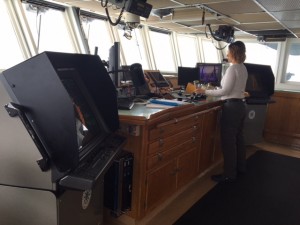17 March 2016
Making it all work: the crew
Posted by larryohanlon
by Nanci Bompey
Nanci Bompey is AGU’s public information manager. She is spending a week aboard the R/V Oceanus with scientists from Oregon State University who are studying the role that small rivers play in the productivity of the coastal ocean during the winter. Click here to read Nanci’s previous blogs from this trip.
Wednesday is the last day of the cruise – we are zig-zagging back along the coast and will head back to Newport tonight. I am finally getting the hang of walking and living on a continuously rocking boat, including being shuttled across the lab on a rolling office chair when there’s a big swell. I’ve also realized how many people, all working together, it takes to pull off a research cruise.
There is, of course, the science crew. On this cruise, there’s the chief scientist, Miguel Goni, and two other scientists: Angel White and Kipp Shearman. Miguel, Angel and Kipp all have teams made up of lab technicians, students and volunteers helping them to take samples and process data. Operations on the cruise are 24/7 so the teams are split into a day shift and a night shift, and the ship is continually sampling at various stations. The laboratory where the science crew works is the heart of the ship and nearly every available spot of bench space is taken up by instruments and computers – all of which need to be secured and tied down. It is very interesting to see the researchers pouring, filtering and working in the lab while the boat rocks back and forth.
In addition to the science crew, there is, of course, the crew of the ship. There’s the captain and the mates, who operate the ship and spend most of their time on the bridge; the engineers, who keep the lights on and the ship moving; the cook and his assistant, who cook multiple-course meals on a moving ship in a kitchen the size of one found in a small apartment; and the able-bodied seamen who help the scientists deploy their instruments and perform other tasks around the ship.
There are also two marine technicians, or mar techs, on the cruise, that serve as linkage between the science party and the ship’s crew. The main duty of the mar techs is to ensure that high-quality data is being collected from the ship’s instruments from their small station above the lab, and perform any repairs that are needed. Along with other members of the crew, the mar techs help to deploy instruments off the deck of the ship.
Not only is it interesting to see all the people it takes to pull off an ocean research cruise, it is also interesting to get to know members of the crew and find out how they ended up on the R/V Oceanus. One of the mates spent years on huge container ships before down-sizing to the Oceanus, while the other mate is an accomplished cellist. The ship’s cook started his career on navy submarines, and one of the mar techs was working for the EPA on the Great Lakes before coming to Oregon. An engineer who has been with the Oceanus for many years was on the ship when it sailed through the Panama Canal on its way from Woods Hole to Newport, Oregon.





 GeoSpace is a blog on Earth and space science, managed by AGU’s Public Information staff. The blog features posts by AGU writers and guest contributors on all sorts of relevant science topics, but with a focus on new research and geo and space sciences-related stories that are currently in the news.
GeoSpace is a blog on Earth and space science, managed by AGU’s Public Information staff. The blog features posts by AGU writers and guest contributors on all sorts of relevant science topics, but with a focus on new research and geo and space sciences-related stories that are currently in the news.